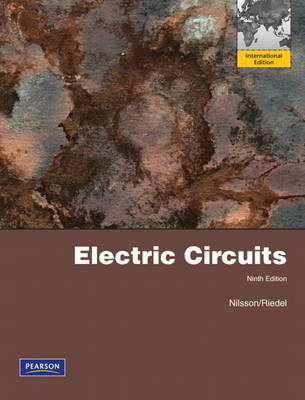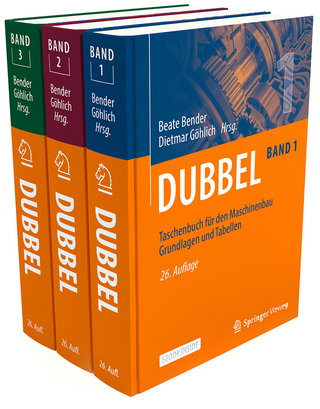
Electric Circuits plus MasteringEngineering Student Access Card
Pearson Education Limited
978-1-4082-9587-8 (ISBN)
- Titel ist leider vergriffen;
keine Neuauflage - Artikel merken
Electric Circuits 9/e is the most widely used introductory circuits textbook of the past 25 years. As this book has evolved over the years to meet the changing learning styles of students, importantly, the underlying teaching approaches and philosophies remain unchanged. The goals are:
- To build an understanding of concepts and ideas explicitly in terms of previous learning
- To emphasize the relationship between conceptual understanding and problem solving approaches
- To provide students with a strong foundation of engineering practices.
Professor JAMES W NILSSON taught at Iowa State University for 39 years. Since retiring from Iowa State, he has been a visiting professor at Notre Dame, California Polytechnic at San Luis Obispo, and the United States Air Force Academy. In 1962, he co-authored (with R.G. Brown) Introduction to Linear Systems Analysis (John Wiley & Sons). In 1968, he authored Introduction to Circuits, Instruments, and Electronics (Harcourt Brae and World). Professor Nilsson received a Standard Oil Outstanding Teacher Award in 1968, the IEEE Undergraduate Teaching Award in 1992, and the McGraw-Hill Jacob Millman Award in 1995. In 1990, he was elected to the rank of Fellow in the Institute of Electrical and Electronics Engineers. Professor SUSAN A. RIEDEL has been a member of the Department of Electrical and Computer Engineering at Marquette University since 1981. She also holds a clinical research appointment in the Department of Orthopaedics at the Medical College of Wisconsin and was a visiting professor in the Bioengineering Unit at the University of Strathclyde, Glasgow, Scotland, as a Fulbright Scholar during the 1989-90 academic year. She has received two awards for teaching excellence at Marquette, and was recognized for her research contributions with an award from the Chicago Unit of the Shriner's Hospitals.
List of Examples xiii
Preface xvii
Chapter 1 Circuit Variables 2
Practical Perspective: Balancing Power 3
1.1 Electrical Engineering: An Overview 4
1.2 The International System of Units 8
1.3 Circuit Analysis: An Overview 10
1.4 Voltage and Current 11
1.5 The Ideal Basic Circuit Element 12
1.6 Power and Energy 14
Practical Perspective: Balancing Power 17
Summary 18
Problems 19
Chapter 2 Circuit Elements 24
Practical Perspective: Electrical Safety 25
2.1 Voltage and Current Sources 26
2.2 Electrical Resistance (Ohm's Law) 30
2.3 Construction of a Circuit Model 34
2.4 Kirchhoff's Laws 37
2.5 Analysis of a Circuit Containing Dependent Sources 42
Practical Perspective: Electrical Safety 46
Summary 47
Problems 48
Chapter 3 Simple Resistive Circuits 56
Practical Perspective: A Rear Window Defroster 57
3.1 Resistors in Series 58
3.2 Resistors in Parallel 59
3.3 The Voltage-Divider and Current-DividerCircuits 61
3.4 Voltage Division and Current Division 64
3.5 Measuring Voltage and Current 66
3.6 Measuring Resistance The Wheatstone Bridge 69
3.7 Delta-to-Wye (Pi-to-Tee) Equivalent Circuits 71
Practical Perspective: A Rear Window Defroster 73
Summary 76
Problems 77
Chapter 4 Techniques of Circuit Analysis 88
Practical Perspective: Circuits with Realistic Resistors 89
4.1 Terminology 90
4.2 Introduction to the Node-Voltage Method 93
4.3 The Node-Voltage Method and Dependent Sources 95
4.4 The Node-Voltage Method: Some Special Cases 96
4.5 Introduction to the Mesh-Current Method 99
4.6 The Mesh-Current Method and Dependent Sources 102
4.7 The Mesh-Current Method: Some Special Cases 103
4.8 The Node-Voltage Method Versus the Mesh-Current Method 106
4.9 Source Transformations 109
4.10 Thevenin and Norton Equivalents 113
4.11 More on Deriving a Thevenin Equivalent 117
4.12 Maximum Power Transfer 120
4.13 Superposition 122
Practical Perspective: Circuits with Realistic Resistors 125
Summary 129
Problems 130
Chapter 5 The Operational Amplifier 144
Practical Perspective: Strain Gages 145
5.1 Operational Amplifier Terminals 146
5.2 Terminal Voltages and Currents 146
5.3 The Inverting-Amplifier Circuit 150
5.4 The Summing-Amplifier Circuit 152
5.5 The Noninverting-Amplifier Circuit 153
5.6 The Difference-Amplifier Circuit 155
5.7 A More Realistic Model for the Operational Amplifier 159
Practical Perspective: Strain Gages 162
Summary 164
Problems 165
Chapter 6 Inductance, Capacitance, and Mutual Inductance 174
Practical Perspective: Proximity Switches 175
6.1 The Inductor 176
6.2 The Capacitor 182
6.3 Series-Parallel Combinations of Inductance and Capacitance 187
6.4 Mutual Inductance 189
6.5 A Closer Look at Mutual Inductance 193
Practical Perspective: Proximity Switches 200
Summary 203
Problems 204
Chapter 7 Response of First-Order RL and RC Circuits 212
Practical Perspective: A Flashing Light Circuit 213
7.1 The Natural Response of an RL Circuit 214
7.2 The Natural Response of an RC Circuit 220
7.3 The Step Response of RL and RC Circuits 224
7.4 A General Solution for Step and Natural Responses 231
7.5 Sequential Switching 236
7.6 Unbounded Response 240
7.7 The Integrating Amplifier 241
Practical Perspective: A Flashing Light Circuit 245
Summary 246
Problems 247
Chapter 8 Natural and Step Responses of RLC Circuits 264
Practical Perspective: An Ignition Circuit 265
8.1 Introduction to the Natural Response of a Parallel RLC Circuit 266
8.2 The Forms of the Natural Response of a Parallel RLC Circuit 270
8.3 The Step Response of a Parallel RLC Circuit 280
8.4 The Natural and Step Response of a Series RLC Circuit 285
8.5 A Circuit with Two Integrating Amplifiers 289
Practical Perspective: An Ignition Circuit 294
Summary 297
Problems 298
Chapter 9 Sinusoidal Steady-State Analysis 306
Practical Perspective: A Household Distribution Circuit 307
9.1 The Sinusoidal Source 308
9.2 The Sinusoidal Response 311
9.3 The Phasor 312
9.4 The Passive Circuit Elements in the Frequency Domain 317
9.5 Kirchhoff's Laws in the Frequency Domain 321
9.6 Series, Parallel, and Delta-to-Wye Simplifications 322
9.7 Source Transformations and Thevenin-Norton Equivalent Circuits 329
9.8 The Node-Voltage Method 332
9.9 The Mesh-Current Method 333
9.10 The Transformer 334
9.11 The Ideal Transformer 338
9.12 Phasor Diagrams 344
Practical Perspective: A Household Distribution Circuit 346
Summary 347
Problems 348
Chapter 10 Sinusoidal Steady-State Power Calculations 360
Practical Perspective: Heating Appliances 361
10.1 Instantaneous Power 362
10.2 Average and Reactive Power 363
10.3 The rms Value and Power Calculations 368
10.4 Complex Power 370
10.5 Power Calculations 371
10.6 Maximum Power Transfer 378
Practical Perspective: Heating Appliances 384
Summary 386
Problems 387
Chapter 11 Balanced Three-Phase Circuits 398
Practical Perspective: Transmission and Distribution of Electric Power 399
11.1 Balanced Three-Phase Voltages 400
11.2 Three-Phase Voltage Sources 401
11.3 Analysis of the Wye-Wye Circuit 402
11.4 Analysis of the Wye-Delta Circuit 407
11.5 Power Calculations in Balanced Three-Phase Circuits 410
11.6 Measuring Average Power in Three-Phase Circuits 415
Practical Perspective: Transmission and Distribution of Electric Power 418
Summary 419
Problems 420
Chapter 12 Introduction to the Laplace Transform 428
Practical Perspective: Transient Effects 429
12.1 Definition of the Laplace Transform 430
12.2 The Step Function 431
12.3 The Impulse Function 433
12.4 Functional Transforms 436
12.5 Operational Transforms 437
12.6 Applying the Laplace Transform 442
12.7 Inverse Transforms 444
12.8 Poles and Zeros of F(s) 454
12.9 Initial- and Final-Value Theorems 455
Practical Perspective: Transient Effects 458
Summary 459
Problems 460
Chapter 13 The Laplace Transform in Circuit Analysis 466
Practical Perspective: Surge Suppressors 467
13.1 Circuit Elements in the s Domain 468
13.2 Circuit Analysis in the s Domain 470
13.3 Applications 472
13.4 The Transfer Function 484
13.5 The Transfer Function in Partial Fraction Expansions 486
13.6 The Transfer Function and the Convolution Integral 489
13.7 The Transfer Function and the Steady-State Sinusoidal Response 495
13.8 The Impulse Function in Circuit Analysis 498
Practical Perspective: Surge Suppressors 505
Summary 506
Problems 507
Chapter 14 Introduction to Frequency Selective Circuits 522
Practical Perspective: Pushbutton Telephone Circuits 523
14.1 Some Preliminaries 524
14.2 Low-Pass Filters 526
14.3 High-Pass Filters 532
14.4 Bandpass Filters 536
14.5 Bandreject Filters 545
Practical Perspective: Pushbutton Telephone Circuits 550
Summary 550
Problems 551
Chapter 15 Active Filter Circuits 558
Practical Perspective: Bass Volume Control 559
15.1 First-Order Low-Pass and High-Pass Filters 560
15.2 Scaling 564
15.3 Op Amp Bandpass and Bandreject Filters 566
15.4 Higher Order Op Amp Filters 573
15.5 Narrowband Bandpass and Bandreject Filters 586
Practical Perspective: Bass Volume Control 591
Summary 594
Problems 595
Chapter 16 Fourier Series 604
Practical Perspective: Active High-Q Filters 605
16.1 Fourier Series Analysis: An Overview 607
16.2 The Fourier Coefficients 608
16.3 The Effect of Symmetry on the Fourier Coefficients 611
16.4 An Alternative Trigonometric Form of the Fourier Series 617
16.5 An Application 619
16.6 Average-Power Calculations with Periodic Functions 623
16.7 The rms Value of a Periodic Function 626
16.8 The Exponential Form of the Fourier Series 627
16.9 Amplitude and Phase Spectra 630
Practical Perspective: Active High-Q Filters 632
Summary 634
Problems 635
Chapter 17 The Fourier Transform 644
Practical Perspective: Filtering Digital Signals 645
17.1 The Derivation of the Fourier Transform 646
17.2 The Convergence of the Fourier Integral 648
17.3 Using Laplace Transforms to Find Fourier Transforms 650
17.4 Fourier Transforms in the Limit 653
17.5 Some Mathematical Properties 655
17.6 Operational Transforms 657
17.7 Circuit Applications 661
17.8 Parseval's Theorem 664
Practical Perspective: Filtering Digital Signals 671
Summary 672
Problems 672
Chapter 18 Two-Port Circuits 678
Practical Perspective: Characterizing an Unknown Circuit 679
18.1 The Terminal Equations 680
18.2 The Two-Port Parameters 681
18.3 Analysis of the Terminated Two-Port Circuit 689
18.4 Interconnected Two-Port Circuits 694
Practical Perspective: Characterizing an Unknown Circuit 697
Summary 698
Problems 698
Appendix A The Solution of Linear Simultaneous Equations 705
A.1 Preliminary Steps 705
A.2 Cramer's Method 706
A.3 The Characteristic Determinant 706
A.4 The Numerator Determinant 706
A.5 The Evaluation of a Determinant 707
A.6 Matrices 709
A.7 Matrix Algebra 710
A.8 Identity, Adjoint, and Inverse Matrices 714
A.9 Partitioned Matrices 717
A.10 Applications 720
Appendix B Complex Numbers 725
B.1 Notation 725
B.2 The Graphical Representation of a Complex Number 726
B.3 Arithmetic Operations 727
B.4 Useful Identities 728
B.5 The Integer Power of a Complex Number 729
B.6 The Roots of a Complex Number 729
Appendix C More on Magnetically Coupled Coils and Ideal Transformers 731
C.1 Equivalent Circuits for Magnetically Coupled Coils 731
C.2 The Need for Ideal Transformers in the Equivalent Circuits 735
Appendix D The Decibel 739
Appendix E Bode Diagrams 741
E.1 Real, First-Order Poles and Zeros 741
E.2 Straight-Line Amplitude Plots 742
E.3 More Accurate Amplitude Plots 746
E.4 Straight-Line Phase Angle Plots 747
E.5 Bode Diagrams: Complex Poles and Zeros 749
E.6 Amplitude Plots 751
E.7 Correcting Straight-Line Amplitude Plots 752
E.8 Phase Angle Plots 755
Appendix F An Abbreviated Table of Trigonometric Identities 759
Appendix G An Abbreviated Table of Integrals 761
Appendix H Common Standard Component Values 763
Answers to Selected Problems 765
Index 781
| Erscheint lt. Verlag | 15.8.2011 |
|---|---|
| Verlagsort | Harlow |
| Sprache | englisch |
| Maße | 217 x 275 mm |
| Gewicht | 1590 g |
| Themenwelt | Technik ► Elektrotechnik / Energietechnik |
| ISBN-10 | 1-4082-9587-3 / 1408295873 |
| ISBN-13 | 978-1-4082-9587-8 / 9781408295878 |
| Zustand | Neuware |
| Haben Sie eine Frage zum Produkt? |
aus dem Bereich


